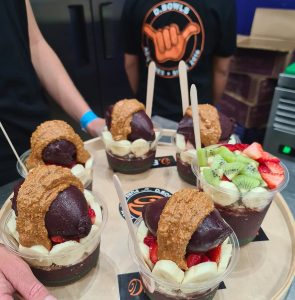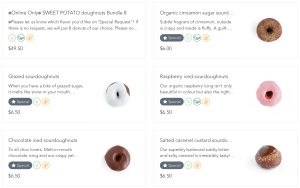
It’s no surprise that the food industry has changed a lot over the last few years. First, COVID-19 disrupted the world and brought food production (and everything else) to a halt. Then, from 2020 onwards, we’ve been experiencing a labor shortage, inflation, and rising food costs. Consumer sentiments have also been shifting, as people are increasingly striving for healthier bodies and a healthier planet.
So, what do these changes mean for restaurateurs? While your concept may be timeless, external factors affect what your customers crave. You need to strike the right balance between incorporating trends into your business and remaining true to your business.
Hopefully our guide to 2023 food trends will inspire you to create an exciting, timely menu while also staying authentic to your vision.
These are the top culinary trends we’re seeing in restaurants in 2023:
- Plant-based foods
- Sustainability
- Functional foods
- Gluten free
- Tinned fish
- Zero and low ABV beverages
Promoting your venue can be a daunting task, especially if you don’t know where to start. Thankfully, we have just the eGuide for you.6 Proven Ways To Promote Your Venue
Plant-based foods
This year we’re seeing more people opt for plant-based options, even if they don’t ascribe to vegetarian or vegan diets. With meat production linked to climate change, consumers are reducing their impact on the planet by relying less on meat.
And more and more Australians are warming up to the idea of plant-based foods, with a projected 34% likely to convert to veganism or vegetarianism.
How to implement this 2023 food trend:
- Introduce Meatless Mondays
- Add more plant-based options to your menu
- Label what’s plant-based on your menu
- Emphasise plant-based options in your marketing
- Add plant-based meats like Beyond Meat and Impossible Foods options to appeal to carnivores
Example of plant-based foods in restaurants

Gigi Pizzeria was already wildly successful before they made the decision to change to a plant-based menu. Now, their entire offering is plant-based including homemade vegan cheese and plant-based meats, aimed at appealing to everybody, regardless of their diet.
Sustainability
Consumers want to take care of the planet. More than half of Australian consumers consider sustainability an important factor when considering a purchase. Sustainability in the hospitality industry can mean a number of things, like sourcing food from local farms and vendors that strive to reduce carbon emissions during production.
Sustainability doesn’t just apply to food. It also applies to packaging. While diners have become dependent on takeout during the pandemic, those who are climate-conscious are looking for more greener ways to enjoy the habit. They’re seeking out restaurants that offer alternatives to single-use takeout containers.
Sustainability also extends to the built environment. The first step to reducing your impact on the planet is conducting an audit of your restaurant’s energy and water consumption and making changes from there.
How to implement this 2023 culinary trend:
- Use local suppliers whenever possible
- Highlight on your menu where your food comes from
- Reduce food waste with an inventory management system
- Partner with food waste companies like OzHarvest
- Install energy-efficient fixtures and fittings in your venues such as motion-activated light switches and sinks, low-flush toilets, and energy-efficient appliances
Example of sustainability in hospitality
Young Henrys is reducing its carbon emissions and making itself more sustainable via initiatives like the Algae Project and community-driven solar power used to run its brewery. They also offer takeaway beers in reusable growlers direct from the tap at their tasting bar, reducing single-use takeaway containers.
Restaurant Employee Handbook Template
Standardize your restaurant's policies, guidelines and processes with your custom restaurant employee handbook.
Functional foods
The phrase “you are what you eat” is more top of mind for diners now than ever before, with demand for fortified and functional foods expected to reach $9.7 billion by 2030. Consumers are increasingly concerned that highly processed foods could lead to disease. In the 1980s, the Japanese government created a class of “functional foods” that included additional health benefits beyond those covered by basic nutrition. These foods include fish, berries, nuts, whole grains, and beans. “Superfoods” like acai, quinoa, and kale are also considered functional. Food as medicine is the focus of the functional food trend.
How to implement this 2023 food trend:
- Highlight dishes that feature functional foods on your menu
- Introduce more dishes that use these ingredients
- Promote functional foods in your restaurant’s marketing
Example of functional foods in cafes

D. Bowls offer a wide range of functional foods, most notably their acai bowls made with homemade peanut butter and granola. Their menu also includes savoury options featuring fresh sushi, lean meats like chicken and plant-based options such as shitake mushrooms.
Gluten free
From athletes like Novak Djokovic crediting his gluten free diet to better performance on the tennis court. Coeliac Australia estimates that around 1 in 70 Australians are affected by coeliac disease, so the public is increasingly seeking gluten free options. Whether diners need to avoid this protein found in wheat, barley, and rye, or are doing it to keep up with trends, your restaurant should accommodate the needs of diners with gluten free diets.
How to implement this food trend for 2023:
- Many glutenous items can be made gluten free easily by making simple swaps, such as:
- Trading wheat flour for a gluten free flour
- Trading soy sauce, which contains wheat, for tamari
- Offering a gluten free pasta option
- Offering cauliflower crust as an option for pizza
- Adding a dedicated gluten free fryer to your kitchen to avoid cross contamination
- Labelling what’s gluten free on your menu
- Training servers and kitchen staff about the needs of diners with celiac disease
Example of gluten-free foods in hospitality

Comeco Foods in Newtown is 100% gluten free, dairy free and vegan. They make their own baked goods and sweet treats, including fresh breads made with rice flour and “sourdoughnuts” made with a starter born from organic brown rice.
Tinned fish
Thanks to TikTok, tinned fish has become a major food trend for 2023. We’re not talking about tuna. A big part of Spanish and Portuguese culture, conservas containing sardines, mackerel, squid, and other gourmet seafoods are stealing the show on TikTok. Canned fish videos have gotten almost 65 million views on the platform.
How to implement this 2023 food trend:
- Add tinned fish to your menu
- Host a tinned fish tasting class to educate customers and draw buzz
- Show off your restaurant’s conserva offerings on TikTok
Example of tinned fish in restaurants

Newtown’s Continental Deli offers a wide range of tinned fish for their customers to enjoy as part of their meal or just a snack whilst enjoying a drink at the bar. They can be served alone with some fresh bread or as part of a plate featuring fresh cheeses, sliced meats and other appetisers.
Zero & low ABV beverages
Dry July is now a year-round phenomenon thanks to this 2023 food trend. Zero alcohol and less boozy drinks are making a splash (apologies), and whether diners just want to lead healthier lifestyles, minimised hangovers, or are avoiding alcohol for other reasons, restaurants and bars are making this easier than ever before.
While passing on drinks may have raised suspicions in the past, the popularity of zero-alcohol beer, like Heaps Normal, have made a sober lifestyle en vogue. Consider adding mocktails and low ABV options to your menu.
How to implement this food and drink trend for 2023:
- Add mocktails to your cocktail menu
- Build a mocktail-based menu and offer booze as an upsell
- Offer zero-proof and low ABV alternatives to wine and beer
Example of non-alcoholic drinks in bars
If you think that offering a non-alcoholic menu is the territory of lesser bars, think again. Sydney’s Maybe Sammy currently occupies 29th position on the World’s 50 Best Bars list and put just as much dedication into their juices & sodas as they do into their alcoholic offerings.
2024 Report: Hospitality Insights and Dining Dynamics
A survey of Australian hospitality operators and consumers reveals in-depth insights on dining trends, the financial shifts in Australia, restaurant technology and what to watch in 2024.
Wrapping up: 2023 food and beverage trends
Every year brings exciting new food trends in Australia, and 2023 is no different. The pull towards sustainable, allergen-free foods reflects a larger societal trend towards holistic wellness. Stay curious and open-minded when it comes to food trends, but incorporate them in a way that’s authentic to your restaurant.
Learn how Lightspeed POS can help you supercharge your restaurant operations. Talk to an expert today.

News you care about. Tips you can use.
Everything your business needs to grow, delivered straight to your inbox.



